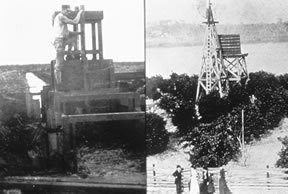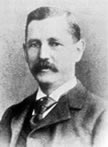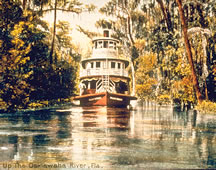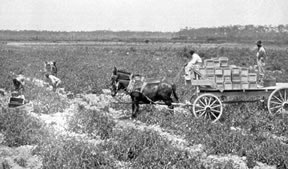1893
The earliest Florida law on drainage of swamp and overflowed lands was enacted. The Delta Canal Company completed canals from Lakes Apopka, Dora, Eustis and Griffin into the Ocklawaha River.
1886
Freeze and a hurricane destroyed north-central Florida’s citrus industry.

One of Florida’s original crops, oranges are still a symbol of the state in the new century. Citrus farmers pick the fruit synonymous with the Sunshine State.
1884
Mrs. W.F. Fuller planted waterhyacinths along the shore of her home on the St. Johns River. The waterhyacinth would later become an exotic, invasive plant in Florida waterways.
Feb. 26, 1881
The Board of Trustees of the State Internal Improvement Trust Fund conveyed four million acres in central and south Florida to Hamilton Disston of Philadelphia on the condition that he drain land to attract agricultural development. Disston worked until 1889 and succeeded in constructing canals between several of the Kissimmee chain of lakes, and between the Caloosahatchee River and Lake Okeechobee.

Hamilton Disston:
Credited with building canals across central and southern Florida to drain lands for agriculture.
1875
The Ocklawaha River is “the sweetest water-lane in the world,” and Silver Springs Run is a “journey over transparency.”

A postcard from yesteryear shows a steamboat making its way along the Ocklawaha River, taking tourists into the natural wilds of Florida.
1870
Jacksonville became a major port for lumber production and export.
1868
Florida’s first water pollution law established a penalty for defiling or corrupting springs and water supplies.
1861
The Florida Railroad Company, headed by U.S. Sen. David Levy Yulee, completed the first cross-state rail line from Fernandina to Cedar Key.
1860
Florida’s population reached 140,000.
1850
The federal government conveyed the titles to 20 million acres of sovereign lands and wetlands to the state of Florida through an act that transferred all “land unfit for cultivation due to its swampy and overflowed condition.” Wetlands throughout the state were drained to maximize agricultural and residential development.

In the early days of farming in Florida, harvesting meant long days of hand labor.
March 3, 1845
Florida was granted statehood. Congress later granted 500,000 acres of land to the state for “internal improvements.”
1827
“In appearance it (northern Florida) is entirely unlike any part of the United States. The lakes abound in fish — trout, brim, perch and soft-shelled turtle — and in the winter with wild fowl.”
– Judge Henry M. Brackenridge

